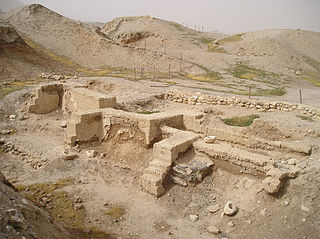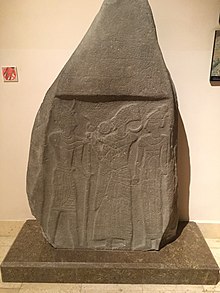
The history of Jordan refers to the history of the Hashemite Kingdom of Jordan and the background period of the Emirate of Transjordan under British protectorate as well as the general history of the region of Transjordan.

Canaan was a Semitic-speaking civilization and region of the Southern Levant in the Ancient Near East during the late 2nd millennium BC. Canaan had significant geopolitical importance in the Late Bronze Age Amarna Period as the area where the spheres of interest of the Egyptian, Hittite, Mitanni, and Assyrian Empires converged or overlapped. Much of present-day knowledge about Canaan stems from archaeological excavation in this area at sites such as Tel Hazor, Tel Megiddo, En Esur, and Gezer.

Qetesh was a goddess who was incorporated into the ancient Egyptian religion in the late Bronze Age. Her name was likely developed by the Egyptians based on the Semitic root Q-D-Š meaning 'holy' or 'blessed,' attested as a title of El and possibly Athirat and a further independent deity in texts from Ugarit.

Shechem, also spelled Sichem was an ancient city in the southern Levant. Mentioned as a Canaanite city in the Amarna Letters, it later appears in the Hebrew Bible as the first capital of the Kingdom of Israel following the split of the United Monarchy. According to Joshua 21:20–21, it was located in the tribal territorial allotment of the tribe of Ephraim. Shechem declined after the fall of the northern Kingdom of Israel. The city later regained its importance as a prominent Samaritan center during the Hellenistic period.

Beit She'an, also Beth-shean, formerly Beisan, is a town in the Northern District of Israel. The town lies at the Beit She'an Valley about 120 m below sea level.

The Mesha Stele, also known as the Moabite Stone, is a stele dated around 840 BCE containing a significant Canaanite inscription in the name of King Mesha of Moab. Mesha tells how Chemosh, the god of Moab, had been angry with his people and had allowed them to be subjugated to the Kingdom of Israel, but at length, Chemosh returned and assisted Mesha to throw off the yoke of Israel and restore the lands of Moab. Mesha also describes his many building projects. It is written in a variant of the Phoenician alphabet, closely related to the Paleo-Hebrew script.

Dan is an ancient city mentioned in the Hebrew Bible, described as the northernmost city of the Kingdom of Israel, and belonging to the tribe of Dan.

The Palermo Stone is one of seven surviving fragments of a stele known as the Royal Annals of the Old Kingdom of Ancient Egypt. The stele contained a list of the kings of Egypt from the First Dynasty through to the early part of the Fifth Dynasty and noted significant events in each year of their reigns. It was probably made during the Fifth Dynasty. The Palermo Stone is held in the Regional Archeological Museum Antonio Salinas in the city of Palermo, Italy, from which it derives its name.
The Canaanite languages, sometimes referred to as Canaanite dialects, are one of three subgroups of the Northwest Semitic languages, the others being Aramaic and Amorite. These closely related languages originate in the Levant and Mesopotamia, and were spoken by the ancient Semitic-speaking peoples of an area encompassing what is today Israel, Jordan, the Sinai Peninsula, Lebanon, Syria, Palestine, as well as some areas of southwestern Turkey (Anatolia), western and southern Iraq (Mesopotamia) and the northwestern corner of Saudi Arabia.

Gezer, or Tel Gezer, in Arabic: تل الجزر – Tell Jezar or Tell el-Jezari is an archaeological site in the foothills of the Judaean Mountains at the border of the Shfela region roughly midway between Jerusalem and Tel Aviv. It is now an Israeli national park. In the Hebrew Bible, Gezer is associated with Joshua and Solomon.

The Rockefeller Archeological Museum, formerly the Palestine Archaeological Museum, is an archaeology museum located in East Jerusalem, next to Herod's Gate, that houses a large collection of artifacts unearthed in the excavations conducted in the region of Palestine, mainly in the 1920s and 1930s, under the British authorities.

Dhiban, known to the Moabites as Dibon, is a Jordanian town located in Madaba Governorate, approximately 70 kilometres south of Amman and east of the Dead Sea. Previously nomadic, the modern community settled the town in the 1950s. Dhiban's current population is about 15,000, with many working in the army, government agencies, or in seasonal agricultural production. A number of young people study in nearby universities in Karak, Madaba, and Amman. Most inhabitants practice Islam.

Levantine archaeology is the archaeological study of the Levant. It is also known as Syro-Palestinian archaeology or Palestinian archaeology. Besides its importance to the discipline of Biblical archaeology, the Levant is highly important when forming an understanding of the history of the earliest peoples of the Stone Age.

The Kerak Inscription, also known as the Kemoshyat inscription, was discovered in 1958 in Jordan, near Wadi el-Kerak. It is a basalt inscription fragment measuring 12.5 centimeters (4.9 in) high by 14 centimeters (5.5 in) wide. The inscription has been dated to the late ninth century BC. The inscription is known as KAI 306.

Nehesy Aasehre (Nehesi) was a ruler of Lower Egypt during the fragmented Second Intermediate Period. He is placed by most scholars into the early 14th Dynasty, as either the second or the sixth pharaoh of this dynasty. As such he is considered to have reigned for a short time c. 1705 BC and would have ruled from Avaris over the eastern Nile Delta. Recent evidence makes it possible that a second person with this name, a son of a Hyksos king, lived at a slightly later time during the late 15th Dynasty c. 1580 BC. It is possible that most of the artefacts attributed to the king Nehesy mentioned in the Turin canon, in fact belong to this Hyksos prince.

The Merneptah Stele, also known as the Israel Stele or the Victory Stele of Merneptah, is an inscription by Merneptah, a pharaoh in ancient Egypt who reigned from 1213 to 1203 BCE. Discovered by Flinders Petrie at Thebes in 1896, it is now housed at the Egyptian Museum in Cairo.
Lorenzo Nigro is an Italian archaeologist, novelist and watercolorist. He is Full Professor of Near Eastern Archaeology in the Faculty of Letters and Philosophy at Sapienza University of Rome. He directs three main archaeological expeditions: at Jericho in Palestine, with the Ministry of Tourism and Antiquities, at the Early Bronze Age fortified city, previously unknown, of Khirbet al-Batrawy in the Hashemite Kingdom of Jordan, and at Motya, a Phoenician city in Western Sicily, while also acting as co-director of the Institut national du patrimoine-Sapienza University of Rome Expedition to Carthage in Tunisia. Since 2015 he started the archaeological exploration and protection activities, again in cooperation with the Palestinian Ministry of Tourism and Antiquities, in the Bronze and Iron Age necropolises of the Bethlehem urban area and at the site of Tell esh-Sheikh Abu Zarad, ancient Tappuah. In all these excavations he has been the protagonist of several important discoveries, from the reconstruction of the Bronze Age city at Jericho, to the Temple of the Kothon at Motya, to the entire unknown city of Batrawy with its magnificent fortifications and the Palace of the Copper Axes, and the Broad Room temple. At Motya it has uncovered at least four temples and detailed a prehistoric stratigraphy at the foot of the acropolis showing that the island in Sicily was occupied and known to Mediterranean sailormen since the beginning of the 2nd millennium BC.

The Jordan Museum is located in Ras al-Ein district of Amman, Jordan. Built in 2014, the museum is the largest museum in Jordan and hosts some of the country's most important archaeological findings. Its two main permanent exhibitions are the Dead Sea Scrolls, including the Copper Scroll, and the 9000-year-old ʿAin Ghazal statues, which are among the oldest human statues ever made.

According to the Hebrew Bible, the Tribe of Reuben was one of the twelve tribes of Israel. Unlike the majority of the tribes, the land of Reuben, along with that of Gad and half of Manasseh, was on the eastern side of the Jordan and shared a border with Moab. According to the biblical narrative, the Tribe of Reuben descended from Reuben, the eldest son of the patriarch Jacob. Reuben, along with nine other tribes, is reckoned by the Bible as part of the northern kingdom of Israel, and disappears from history with the demise of that kingdom in c. 723 BC.

The Beisan steles are five Ancient Egyptian steles from the period of Seti I and Ramesses II discovered in what was then known as Beisan, Mandatory Palestine by Alan Rowe in the late 1920s and early 1930s.


















